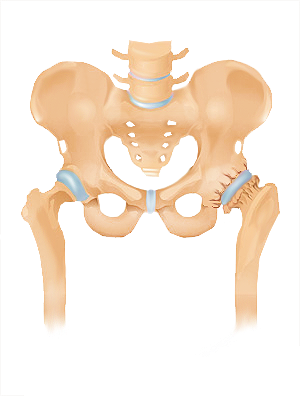Hip Osteoarthritis
What is Osteoarthritis?
 Hip osteoarthritis is a form of arthritis that occurs when the protective cartilage wears out. It is also known as degenerative joint disease and can affect any joint. These joints include the hips, hands, spine, and knees.
Hip osteoarthritis is a form of arthritis that occurs when the protective cartilage wears out. It is also known as degenerative joint disease and can affect any joint. These joints include the hips, hands, spine, and knees.
Cartilage is a firm, rubbery material made up of water and proteins. It covers the ends of bones in healthy joints. Acting as a shock absorber and reducing friction between joints. The shock-absorbing function is a result of its high water content. Which enables to adjust shape when compressed.
However, once the cartilage wears out, it can’t grow back. There are two types of osteoarthritis: primary and secondary. Primary osteoarthritis affects the thumbs, fingers, hips, and knees. However, secondary osteoarthritis occurs as a result of inflammation or injury.
Understanding Hip Osteoarthritis
Hip osteoarthritis the most common reason for hip pain. It causes issues with the ball-and-socket joint at the junction of the pelvis and lower extremity.
Once the cartilage wears, the hip bones are left rubbing against each other, causing pain. However, some bones may grow outwards to make up for the lost cartilage; a condition called osteophytes. Patients who have this condition experience problems when walking while others develop pain in different locations.
Causes of The Condition
Osteoarthritis does not have a single cause. However, the following risk factors make it more likely to develop the disease:
- Increasing age
- Obesity
- Inherited defects
- Joint injury
- Development dysplasia of the hip
- Symptoms of Osteoarthritis
- Pain in the hip joint
- Joint stiffness after an extended period of inactivity
- Grinding noise during movement
- Reduced motion in the hip
How to Diagnose Osteoarthritis
Once you visit the doctor, he will conduct a physical examination. This will be to look for:
- Tenderness in the hip region
- Range of active and passive motion
- Pain when pressure is placed on the hip
- Crepitus upon movement
- Signs of injury to the tendons, muscles and the ligaments surrounding the hip
If the patient does not exhibit any of these symptoms, the doctor will order an X-ray. An X-ray of an arthritic hip shows many different things. First, narrowing on the joint space. Next, bone spurs that may have developed. Lastly, other changes that have occurred in the bone.
Hip Osteoarthritis Treatment
Treatment method will be based on your condition. These methods range from conservative to invasive procedures. However, traditional therapies include joint care, exercise, medication, and weight loss programs.
Invasive Treatment Methods:
Surtgical methods are only necessary if conservative treatments fail. For instance:
- Hip replacement surgery: involves the removal of the damaged ball. Then replacing it with new and durable artificial synthetic parts. The hip joint uses a ball and socket mechanism. When a patient develops osteoarthritis, the socket gets injured. Therefore, causing hip pain or difficulty when walking.
- Hip resurfacing: provides relief for patients who want to delay hip replacement surgery. The ailing hip joint surfaces are removed and substituted with metal. Then, the femur bone is preserved to make future hip replacement procedures possible.
Preventing the Condition
Unfortunately, there is no single way of preventing hip osteoarthrits. However, maintaining a healthy weight keeps it at bay. Above all, exercise helps strengthen the muscles around the joints. Thus preventing wear and tear of the cartilage.
If you are experiencing hip osteoarthritis, contact us today at 888-409-8006 for a hip specialist near you.
